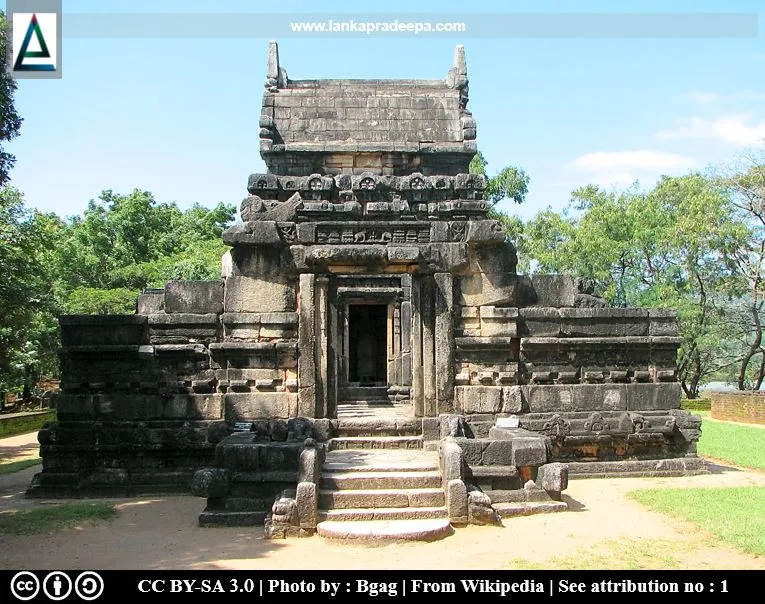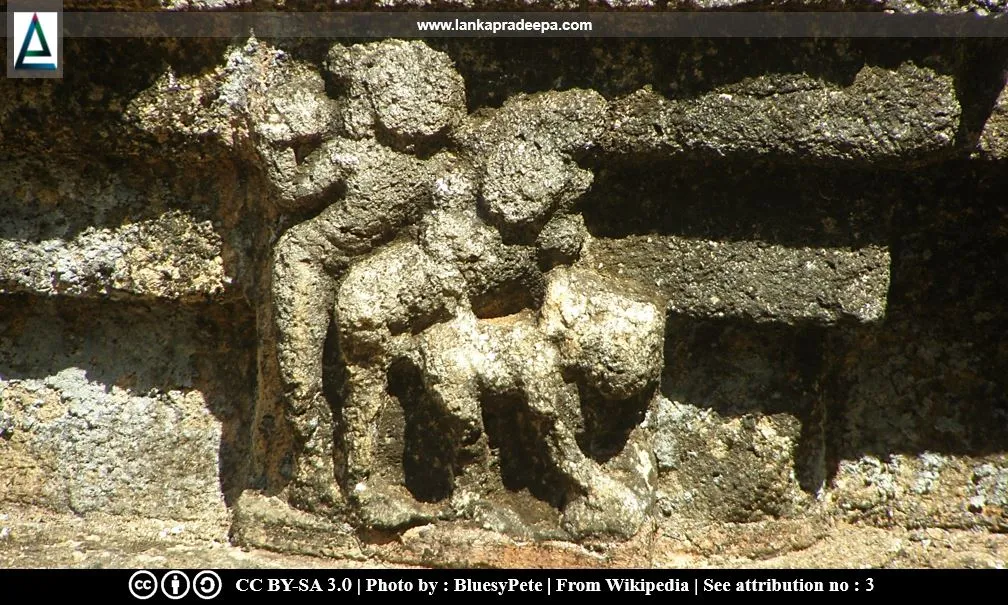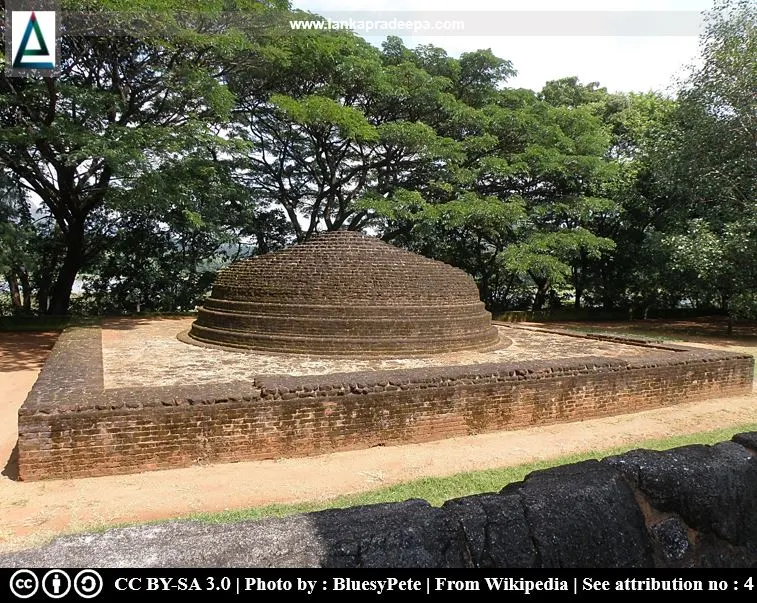
|
Nalanda Gedige |
Nalanda Gedige (Sinhala: නාලන්දා ගෙඩිගේ; Tamil: நாலந்த கெடிகே) is an archaeological site located in Nalanda village in Matale district, Sri Lanka. It is a popular tourist site among the locals due to its unique stone-built Buddha image house. The site can be reached by travelling about 1.4 km distant along the Gedige road that commences at Nalanda junction located on the Matale - Dambulla highway
History
Situated in a central position almost equidistant from the ancient capitals of Anuradhapura, Polonnaruwa, and Kandy, Nalanda was a strategic military position during the campaigns of Sinhalese kings and even of British rulers (Prematilleke, 1985). The Great Chronicle, Mahawamsa records that Parakramabahu I (1153-1186 A.D.), before his enthronement, had built a fortress at Nalanda during his wars against Gajabahu II of Polonnaruwa (1131-1153 A.D.) and Manabharana of Magama (Prematilleke, 1985). As well as British rulers had built a military station at Nalanda during the rebellion of Kandy (1818), but abandoned it in 1841 (Prematilleke, 1985).
However, there is no clear historical or literary evidence that reveals the construction of the monastery at Nalanda (Prematilleke, 1985). The remaining archaeological evidence indicates that the Gedige shrine belonged to the 8-10th century A.D. (Abeyawardana, 2004, Jayasuriya, 2016; Prematilleke, 1985). A pillar inscription belonging to the 9-10 centuries A.D. has been found from the site (Ranawella, 2005).
Inscriptions
A pillar inscription, broken in two, was discovered at a paddy threshing ground located near the present site (Prematilleke, 1985). The complete interpretation of the inscription has become impossible as a large part of it has got effaced. Paleographically, this inscription has been dated to a time between the 9-10 centuries A.D. (Prematilleke, 1985; Ranawella, 2005).
Nalanda Gedige Pillar Inscription
Reign : ?
Period : 9-10 centuries A.D.
Content: This inscription provides information about the Buddhist temple that existed at Nalanda. It records a code of regulations made for the temple. According to the inscription, temple artisans who misbehave should be expelled from the temple ground and that robbers, murderers, and such persons shouldn't enter the temple premises. It further says all matters that relate to the monastery should be carried out with the consensus of resident monks.
Reference : Prematilleke, 1985. p.18
The name of the monastery is not found in the preserved portion. However, the inscription is considered important as its date is in conformity with the architectural style of the Gedige shrine (Jayasuriya, 2016).
Image House
The Nalanda image house has been constructed in conformity with the Ganesha-Ratha style of Mahabalipuram architecture, South India (Abeyawardana, 2004). According to the view of Jayasuriya, this is the only extant Buddha image house in Sri Lanka built in the architectural design norms of the Pallava architecture of Mahabalipuram (Jayasuriya, 2016).
The image house consists of three sections, viz: Gharbha-gruha (shrine room), Mandapa (vestibule), and the entrance porch. The entrance is reached with a flight of steps associated with a Sandakada Pahana (moonstone) and Korawak Gal [(wingstones) Jayarathne, 2014]. The Sandakada Pahana contains no decorations but Korwak Gal are carved with dragon heads and decorative motifs. Images of the Buddha, Bodhisattva Avalokiteshwara, and God Ganesha are found inside the Garbha-gruha (Jayarathne, 2014; Jayasuriya, 2016). Among the various kind of sculptures, the carving depicting an erotic scene between two men, and a woman is considered unusual for a Buddhist temple (Jayasuriya, 2016). According to Jayasuriya, this sculpture shows the influence of Tantric Buddhist ideas on the sculptors at the time (Jayasuriya, 2016).
Archaeologists believe that the Gedige type image house at Nalanda is an example representing the synthesis between Theravada and Mahayana forms of worship as well as the union of both Buddhist and Hindu architectures (Abeyawardana, 2004; Jayasuriya, 2016; Prematilleke, 1985).
Conservation
Conservation work of Nalanda was commenced in 1898, under the supervision of H.C.P. Bell, the then Archaeological Commissioner (Abeyawardana, 2004). However, a full restoration of the temple was started in the 1970s.
In the 1970s, the waters of the newly built Bowatenna Reservoir threatened to flood the shrine (Jayasuriya, 2016). Therefore, a decision was taken to shift the monument to a nearby location and reconstruct it on an elevated ground (Jayasuriya, 2016). In 1975, Dr Prematilleke was appointed as the consultant to replace the shrine (Chandraratne, 2017; Jayasuriya, 2016). Under the supervision of Prematilleke, the edifice was dismantled from its original location and rebuilt at the present site. The conservation work of Nalanda Gedige was completed in 1985 (Chandraratne, 2017).


 .
.
Related Posts
Read Also
References
Books, Journal Articles
1) Abeyawardana, H.A.P., 2004. Heritage of Kandurata: Major natural, cultural and historic sites. Colombo: The Central Bank of Sri Lanka. p.184,316-317.
2) Chandraratne, R.M.M., 2017. The origin, development and current perspectives on archaeology. Social Affairs: A Journal for the Social Sciences. Vol.1. No.7, pp.56-68.
3) Jayarathne, K.G.M.S.K. 2014. බහුසංස්කෘතික ලක්ෂණ විදහාපාන නාලන්දා ගේඩිගේ. Proceedings
of the Undergraduate’s Research Conference on Archaeology, Department of Archaeology, University of Kelaniya, Sri Lanka. p. 47.
4) Jayasuriya, E., 2016. A guide to the Cultural Triangle of Sri Lanka. Central Cultural Fund. ISBN: 978-955-613-312-7. pp.64-65.
5) Prematilleke, P.L., 1985. Nalanda: A short guide to the Gedige shrine. Central Cultural Fund. Ministry of Cultural Affairs. Sri Lanka. pp.7-18.
6) Ranawella, S., 2005. Inscription of Ceylon. Volume V, Part
III. Department of Archaeology. ISBN: 955-91-59-57-7. pp.109-110.
Location Map
Dynamic Google Map
Attribution
To Whom
1) Nalanda Gedige temple by Bgag is licensed under CC BY-SA 3.0
2) Nalanda Gedige 01 by Bgag is licensed under CC BY-SA 3.0
3) Nalanda Gedige - Détail by BluesyPete is licensed under CC BY-SA 3.0
4) Nalanda Gedige - Le stupa by BluesyPete is licensed under CC BY-SA 3.0


